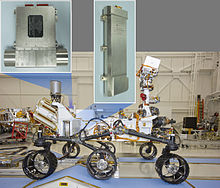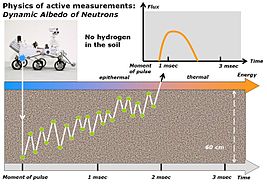Dynamic Albedo of Neutrons
 DAN instrument on the Curiosity rover | |
| Operator | NASA |
|---|---|
| Manufacturer | Russian Space Research Institute (IKI) |
| Instrument type | neutron spectrometer |
| Function | hydrogen and H2O detector |
| Mission duration | Primary: 668 sols (687 days) Current: 4363 sols (4483 days) since landing |
| Began operations | August 6, 2012 |
| Website | msl-scicorner |
| Host spacecraft | |
| Spacecraft | Curiosity rover |
| Operator | NASA |
| Launch date | November 26, 2011, 15:02:00 UTC |
| Launch site | Cape Canaveral LC-41 |
| COSPAR ID | 2011-070A |
The Dynamic Albedo of Neutrons (DAN) instrument is an experiment mounted on the Mars Science Laboratory's Curiosity rover. It is a pulsed sealed-tube neutron source and detector used to measure hydrogen or ice and water at or near the Martian surface.[1][2] The instrument consists of the detector element (DE) and a 14.1 MeV pulsing neutron generator (PNG). The die-away time of neutrons is measured by the DE after each neutron pulse from the PNG. DAN was provided by the Russian Federal Space Agency,[1][2] funded by Russia[3] and is under the leadership of Principal Investigator Igor Mitrofanov.[4]
History
[edit]On August 18, 2012 (sol 12), DAN was turned on,[5] marking the success of a Russian-American collaboration on the surface of Mars and the first working Russian science instrument on the Martian surface since Mars 3 stopped transmitting over forty years ago.[6] The instrument is designed to detect subsurface water.[5]
On March 18, 2013 (sol 218), NASA reported evidence of mineral hydration, likely hydrated calcium sulfate, in several rock samples including the broken fragments of "Tintina" rock and "Sutton Inlier" rock as well as in veins and nodules in other rocks like "Knorr" rock and "Wernicke" rock.[7][8] Analysis using the rover's DAN instrument provided evidence of subsurface water, amounting to as much as 4% water content, down to a depth of 60 cm (2.0 ft), in the rover's traverse from the Bradbury Landing site to the Yellowknife Bay area in the Glenelg terrain.[7]

On August 19, 2015, NASA scientists reported that the DAN instrument on Curiosity detected an unusual hydrogen-rich area, at "Marias Pass," on Mars. The hydrogen found seemed related to water or hydroxyl ions in rocks within three feet beneath the rover, according to the scientists.[9]

See also
[edit]References
[edit]- ^ a b Litvak, M. L.; Mitrofanov, I. G.; Barmakov, Yu. N.; Behar, A.; Bitulev, A.; et al. (2008). "The Dynamic Albedo of Neutrons (DAN) Experiment for NASA's 2009 Mars Science Laboratory". Astrobiology. 8 (3): 605–12. Bibcode:2008AsBio...8..605L. doi:10.1089/ast.2007.0157. PMID 18598140.
- ^ a b "MSL Science Corner: Dynamic Albedo of Neutrons (DAN)". NASA/JPL. Archived from the original on March 20, 2009. Retrieved September 9, 2009.
- ^ "Mars Science Laboratory: Mission". NASA/JPL. Retrieved August 6, 2012.
- ^ Webster, Guy (April 8, 2013). "Remaining Martian Atmosphere Still Dynamic". NASA. Retrieved April 9, 2013.
- ^ a b Harwood, William (August 18, 2012). "Curiosity's Mars travel plans tentatively mapped". CBS News.
- ^ NSSDC – Mars 3
- ^ a b Webster, Guy; Brown, Dwayne (March 18, 2013). "Curiosity Mars Rover Sees Trend In Water Presence". NASA. Archived from the original on April 24, 2013. Retrieved March 20, 2013.
- ^ Rincon, Paul (March 19, 2013). "Curiosity breaks rock to reveal dazzling white interior". BBC News. Retrieved March 19, 2013.
- ^ a b Staff (August 19, 2015). "PIA19809: Curiosity Finds Hydrogen-Rich Area of Mars Subsurface". NASA. Retrieved August 19, 2015.
External links
[edit] Media related to Dynamic Albedo of Neutrons at Wikimedia Commons
Media related to Dynamic Albedo of Neutrons at Wikimedia Commons




